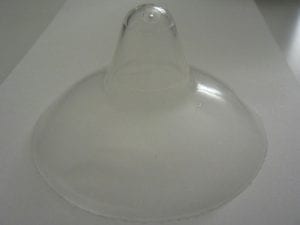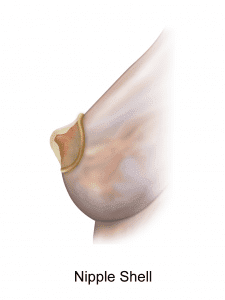Looking for a nipple shield? Nipple shield protects your nipple from baby’s suckle especially when it starts to hurt. When you chat with first-time expectant mothers, you may find one or two who’s excited about the thought of breastfeeding.

Some may say, “Oh, I hear it is the best form of bonding that my baby and I can do after birth!” Others want to do it because they know that breast milk production is rich with all the nutrients that an infant can ever need while he or she still can’t eat real foods. As babies feed with breast milk, they will certainly be gaining weight healthily. This is the reason why a lactation professional or lactation consultant always encourages new moms to breastfeed.
Are you feeling pain when baby latches your breast. Experiencing nipple soreness, especially bleeding nipples, is not uncommon when you establish breastfeeding, particularly if the baby has a retracted tongue or if the mother has very soft breasts. It is essential to address the root causes of nipple soreness to ensure a more comfortable breastfeeding experience for both the mother and the baby.
So what is a nipple shield for? Can a breast guard help decrease nipple pain? How does a baby’s mouth latch on the nipple shield? Can one use nipple guards with swollen breasts? What about those with flat or inverted nipples? How can a baby latch with the shield on? Can a premature baby feed with it? To avoid all kinds of pain when breastfeeding, therefore, you should start using the best nipple shield now. You can find a nipple shield in different shops online.


Have you seen a nipple shield? Have you used a nipple shield? Assuming you have never seen a nursing nipple shield in your lifetime, try to think of the silicone toppers that come with feeding bottles – these mimic nipple shield – the shape is practically the same – there’s the elongated end which serves as the nipple, as well as a slightly wide opening that’s connected to the milk container. The nipple shield has tiny holes on the suckling part or the nipple portion of the nipple shield to let the liquid out.
When Should You Use A Nipple Shield?
A nipple shield can be helpful when dealing with latch difficulties, ensuring that the baby effectively latches onto the breast. A nipple shield also helps if there are concerns about poor weight gain or insufficient milk transfer. Mothers may find a nipple guard beneficial in such cases, as it helps the baby latch onto the entire areola, providing a more secure attachment and facilitating the transfer of extra milk. A nipple shield helps during instances of low milk supply or when the baby struggles with latching.
The Best Time To Use Them
Breast shields or a nipple shield are a lifesaver for occasions when you don’t have enough milk:


Inverted Teat
When do you need a nipple shield? Having flat or inverted nipples can be addressed without the need for a nipple shield. During pregnancy, incorporating techniques such as breast stimulation and using a breast pump can be great tools to encourage the natural protrusion of the nipples. It’s important to explore other methods to avoid potential complications like mastitis and to support healthy breastfeeding.
Are Teat Protection Appropriate To Use In This Case?
Without the nipple shield, first time moms may experience pain when breastfeeding babies. It is normal for some mothers to have inverted nipples? The lactation professional, along with other experts, says that it is biologically possible for some mothers to have nipples that do not stretch even during the suckling process. In certain circumstances, that can frustrate a baby, especially when he or she is hungry. No amount of pulling can fix that but a nipple shield can. Hence, you need a nipple shield to become an extension (sort of an extended nipple) of your flat or inverted nipples.
Moms with flat or inverted nipples have greatly benefited from the emergence of a nipple shield – thank you nipple shield for serving as an extended nipple as it provides an extended position for your baby to achieve! In short, they can provide and be a temporary solution to their problem.
You Want To Start Using Shields For Nipples
A nipple shield can be a helpful tool when you think it’s high time for your son or daughter to stop breastfeeding, or when weaning. But once you use the nipple shield often, the infant may not get fazed much by the sight of a feeding bottle. Indeed, a nipple shield is sort of a practice ground for infants and helps them continue gaining weight healthily.
The Baby Is Nibbling My Nipple
It may be wise to obtain a nipple shield, though, since the infant’s milk teeth can start appearing at this point. If you try to feed him or her during a fuzzy state, the baby – specifically the baby’s mouth – might bite your nipple hard and cause nipple pain, to the extent that it becomes swollen or, worse, bleeds. A nipple shield helps prevent further swelling and nipple pain.
How To Use A Breastfeeding Nipple Shield?
The constant first step is to sterilize the nipple shield with warm or hot water before every use. That will eliminate any germs or bacteria that touched the nipple shield. Then, you have to ensure that the nipple shield fits over your nipple and areola. You may hold the nipple shield in place while the infant’s still trying to latch on them. Once breastfeeding time is over, you should clean the nipple shield with cold and soapy water before putting it in storage again to protect it from breaking easily.
What Kind Of Teat Protection To Get?
A regular nipple guard has a round bottom part that covers the areola completely. Mothers love how it sticks to the skin. If you get a Medela nipple protection, to be specific, you can expect the material to be super thin or ultra-thin. Thus, with Medela nipple guard, the baby may not feel uncomfortable while breastfeeding or experience a poor latch because of trouble latching, even for moms with flat nipples. Nipple pain can be prevented or eliminated.


It matters to note that using a nipple protection is not always recommended by specialists. You should work with a lactation consultant or lactation professional if you have trouble breastfeeding your baby to know whether you need one and for how long. You can also have a talk or work closely with lactation professionals from a hospital in case you experience any kind of nipple pain or breastfeeding issues, they can give you some advice and tips for your little one. Always choose contact nipple shields that are made from organic, non-toxic material.
Frequently Asked Questions
Does Nipple Shield Affect Milk Supply?
Nipple shield is not supposed to provide more milk supply if used correctly. If not, wearing nipple shields may lower your milk supply and cause breast issues, including nipple pain, which is why it is recommended to use a breast pump after breastfeeding with a nipple protector.
Should I Use A Nipple Shield?
Nipple shield is useful for moms with small nipples or premature babies. The breast milk will collect on the tip of the guard, and premature babies can suck it out little by little, making the sucking process slow but surely. Check out more helpful guides here about a nipple protector and premature babies on the Medela page.
Is It Okay To Use Nipple Shield Long-Term?
If you’re planning to continue breastfeeding, yes, you can also continue using a nipple protector for as long as your baby needs it. A nipple protector should not affect your child in any way.
How Should A Nipple Shield Fit?
You know that you are using the correct nipple shield if your entire nipple goes into it. Otherwise, you need to look for a better one. Read more information here: https://www.whattoexpect.com/baby-products/feeding-nutrition/nipple-shields-breastfeeding/.
Why Is Nipple Shield Not Advisable?
How Often Should I Replace Nipple Shield?
When Is A Nipple Shield Usually Used?
How Do I Determine The Type Of Nipple Shield To Use?
What Does Professional Say About Nipple Shield?
Is Nipple Shield Useful?
Why My Nipple Hurt?
Does A Nipple Shield Affect My Milk Flow?
Does The Nipple Shield Supposed To Be Sterilized?
Does A Nipple Shield Help Alleviate Breast Pain?
Why Stop Using Nipple Shield?
Do Nipple Shields Give Babies Gas As They’re Latched By The Baby’s Mouth?
What You Should Avoid During Breastfeeding?
Is It Advisable To Change The Nipple Shield From Time To Time?
Last Updated on April 12, 2023 by Mary Cimeni
DISCLAIMER (IMPORTANT): This information (including all text, images, audio, or other formats on FamilyHype.com) is not intended to be a substitute for informed professional advice, diagnosis, endorsement or treatment. You should not take any action or avoid taking action without consulting a qualified professional. Always seek the advice of your physician or other qualified health provider with any questions about medical conditions. Do not disregard professional medical advice or delay seeking advice or treatment because of something you have read here a FamilyHype.com.